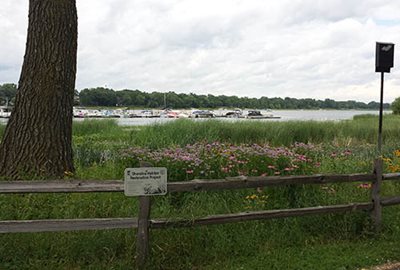It’s 2040 and White Bear Lake is a sustainable and resilient community, prepared to survive and recover quickly from natural disasters. The city’s array of services is accessible by walking, biking, or using public transit. Homes come in all types for all income levels. Healthy foods are readily available, residents are active, and parks are abundant.
The city has reduced its carbon footprint by 80% and solar panels sit atop residential and commercial buildings. A “boulevard” tree planting program improved aesthetics, walkability, and property values. More native species, improved pollinator and wildlife habitat, and water quality and biodiversity have improved...
That’s where the city sees itself in 20 years, as stated in the Natural Resources & Sustainability Chapter of its 2040 Comprehensive Plan. The goal is to “become more resilient in the face of an evolving climate.”
Protecting natural resources is a priority
 “About one-third of the city is composed of wetlands, open space, and lakes,” said Community Development Director Anne Kane. “So, protecting our wealth of natural resources is a priority. But our sustainability planning is wide-ranging and includes preservation of our built environment, our ability to adapt to changing conditions and mitigate impacts of climate change.”
“About one-third of the city is composed of wetlands, open space, and lakes,” said Community Development Director Anne Kane. “So, protecting our wealth of natural resources is a priority. But our sustainability planning is wide-ranging and includes preservation of our built environment, our ability to adapt to changing conditions and mitigate impacts of climate change.”
Among the chapter’s areas of focus:
-
Groundwater supply. Concern about lake levels in White Bear Lake and the city’s emphasis on public awareness of water conservation is paying off with a 20% decline in total water demand over 10 years. The city has also revised its water utility rate structure to a seasonal one to encourage water conservation during summer months.
-
Surface water management. The city has a whole other plan that provides the framework for protecting and improving water quality.
-
Waste reduction. Rethinking our relationship with and discarding material goods—including reuse, recycling, composting. It’s all in the comprehensive plan.
-
Energy. Focus on reducing inefficiencies in energy consumption. Increase use of green energy standards in construction; apply more renewable energy technologies, including more solar panels; get a clearer picture of sources and amounts of greenhouse gas emissions to identify and prioritize areas to target in ways that make the greatest impact.
-
Healthy living. Access to recreational opportunities and quality food; protect and restore native plants and habitat — especially along shorelines. Maximize tree cover, minimize impervious surfaces, and remove invasive species that threaten natural areas.
“The city continues to grow,” said Kane. “Our job is to try to leave it better than we found it and secure a future for those who follow us.”